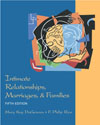 |  Intimate Relationships, Marriages, and Families, 5/e Mary K. DeGenova
Philip F. Rice
Being Single
Chapter ObjectivesAfter reading the chapter, you should be able to:
1.know in general terms the percentages of people in the U.S. population who are married, single, widowed, and divorced and point out cultural/ethnic differences. |
 |  |  | 2.describe the differences between voluntary and involuntary singles. |
 |  |  | 3.sort out myths versus realities about singles. |
 |  |  | 4.explain the reasons for marital delay and why some people remain permanently single. |
 |  |  | 5.understand the advantages and disadvantages of being single, and singles' health and well-being. |
 |  |  | 6.describe the various living arrangements of singles, including the increasing phenomenon of adult children living with their parent(s). |
 |  |  | 7.understand the need of singles for companionship, the difference between loneliness and aloneness, and the differences between males and females in relation to companionship. |
 |  |  | 8.discuss the sexual behavior of singles. |
 |  |  | 9.compare singles with marrieds in relation to employment and level of income. |
 |  |  | 10.discuss the challenges faced by single mothers. |
 |  |  | 11.discuss the life situations of older, never-married adults. |
 |  |  | 12.examine personal attitudes toward being single. |
|



 2002 McGraw-Hill Higher Education
2002 McGraw-Hill Higher Education